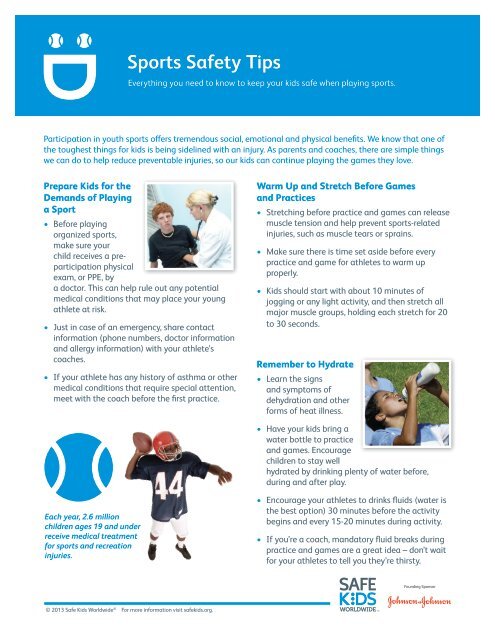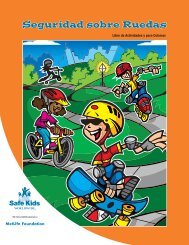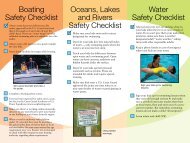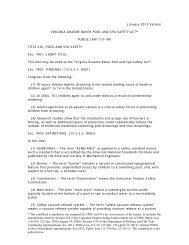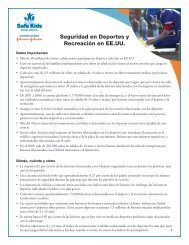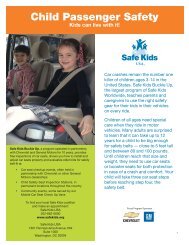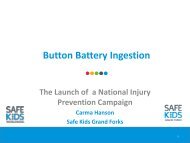Sports Safety Tips - Safe Kids Worldwide
Sports Safety Tips - Safe Kids Worldwide
Sports Safety Tips - Safe Kids Worldwide
- No tags were found...
You also want an ePaper? Increase the reach of your titles
YUMPU automatically turns print PDFs into web optimized ePapers that Google loves.
<strong>Sports</strong> <strong><strong>Safe</strong>ty</strong> <strong>Tips</strong>Everything you need to know to keep your kids safe when playing sports.Participation in youth sports offers tremendous social, emotional and physical benefits. We know that one ofthe toughest things for kids is being sidelined with an injury. As parents and coaches, there are simple thingswe can do to help reduce preventable injuries, so our kids can continue playing the games they love.Prepare <strong>Kids</strong> for theDemands of Playinga Sport• Before playingorganized sports,make sure yourchild receives a preparticipationphysicalexam, or PPE, bya doctor. This can help rule out any potentialmedical conditions that may place your youngathlete at risk.• Just in case of an emergency, share contactinformation (phone numbers, doctor informationand allergy information) with your athlete’scoaches.• If your athlete has any history of asthma or othermedical conditions that require special attention,meet with the coach before the first practice.Warm Up and Stretch Before Gamesand Practices• Stretching before practice and games can releasemuscle tension and help prevent sports-relatedinjuries, such as muscle tears or sprains.• Make sure there is time set aside before everypractice and game for athletes to warm upproperly.• <strong>Kids</strong> should start with about 10 minutes ofjogging or any light activity, and then stretch allmajor muscle groups, holding each stretch for 20to 30 seconds.Remember to Hydrate• Learn the signsand symptoms ofdehydration and otherforms of heat illness.• Have your kids bring awater bottle to practiceand games. Encouragechildren to stay wellhydrated by drinking plenty of water before,during and after play.Each year, 2.6 millionchildren ages 19 and underreceive medical treatmentfor sports and recreationinjuries.• Encourage your athletes to drinks fluids (water isthe best option) 30 minutes before the activitybegins and every 15-20 minutes during activity.• If you’re a coach, mandatory fluid breaks duringpractice and games are a great idea – don’t waitfor your athletes to tell you they’re thirsty.© 2013 <strong>Safe</strong> <strong>Kids</strong> <strong>Worldwide</strong> ®For more information visit safekids.org.
Wear Appropriate<strong>Sports</strong> Gear• Having kids wearthe appropriate andproperly-fitted sportsgear during practiceand games can helpavoid minor andserious injuries.• Make sure athletes have the right equipmentand are wearing it for both practices and games.The right equipment may include helmets, shinguards, mouth guards, ankle braces, shoes withrubber cleats and sunscreen.Don’t Take Chances with the Brain: Knowthe Signs and Symptoms of Concussions• Learn the signs and symptoms of a concussion.This information is important for coaches, parentsand athletes.• A player with a suspected concussion mustbe immediately sidelined until evaluated andreleased by a medical professional. The importantthing is to protect players who have had aconcussion from getting another one.• A good rule of thumb: when in doubt, sit themout.Make Rest a Priority• To help avoid overuseinjury, rest all playersduring practices andgames.• Encourage playersto communicateany pain, injury orillness they may haveduring or after any practices or games. Make surethey know it’s smart to tell coaches, parents oranother adult if they’re hurt or not feeling well.• <strong>Kids</strong> should have at least one or two days offfrom any particular sport each week.• An off-season is important, too. It isrecommended that kids get 10 consecutive weeksof rest from any one sport every year. Playingdifferent sports throughout the year is OK.Be a Prepared Coach• As a coach, establishsafety guidelines thatathletes and parentscan follow duringevery practice andgame, such as creatinghydration breaks,encouraging playersto sit out if injured, resting if not feeling well andfacilitating a proper warm-up.• It’s also a good idea for coaches to get certifiedin first aid and CPR and have a stocked first aid kithandy at all practices and games.• Coaches should consider adding to their sportsskills and knowledge with free sports safetytraining at a <strong>Safe</strong> <strong>Kids</strong> <strong>Sports</strong> <strong><strong>Safe</strong>ty</strong> Clinic.Be a Supportive Parent• Learn ways to help your child stay injury free andhealthy while playing sports.• Attend a sports safety clinic in your area. Theseclinics, such as ones held by <strong>Safe</strong> <strong>Kids</strong> across theUnited States, provide coaches and parents withways to keep young athletes healthy and injuryfree throughout their sporting careers.• Visit www.safekids.org/sports to receive more tipsand resources on youth sports safety and to finda sports safety clinic or <strong>Safe</strong> <strong>Kids</strong> coalition nearyou.© 2013 <strong>Safe</strong> <strong>Kids</strong> <strong>Worldwide</strong> ®For more information visit safekids.org.


